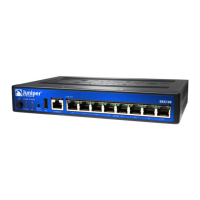The output shows the current configuration. Verify that the values displayed are
correct for your services gateway.
Related Topics ■ SRX100 Services Gateway Basic Connectivity Overview on page 55
■ Connecting an SRX100 Services Gateway to the J-Web Interface on page 60
■ Connecting an SRX100 Services Gateway to the CLI Locally on page 62
■ Connecting an SRX100 Services Gateway to the CLI Remotely on page 64
■ Configuring Basic Settings for the SRX100 Services Gateway with a Configuration
Editor on page 70
SRX100 Services Gateway Secure Web Access Overview
You can manage a services gateway remotely through the J-Web interface. To
communicate with the services gateway, the J-Web interface uses Hypertext Transfer
Protocol (HTTP). HTTP allows easy Web access but no encryption. The data that is
transmitted between the Web browser and the services gateway by means of HTTP
is vulnerable to interception and attack. To enable secure Web access, a services
gateway supports HTTP over Secure Sockets Layer (HTTPS). You can enable HTTP
or HTTPS access on specific interfaces and ports as needed.
The services gateway uses the SSL protocol to provide secure management of services
gateways through the Web interface. SSL uses public-private key technology that
requires a paired private key and an authentication certificate for providing the SSL
service. SSL encrypts communication between your device and the Web browser
with a session key negotiated by the SSL server certificate.
An SSL certificate includes identifying information such as a public key and a signature
made by a certificate authority (CA). When you access the services gateway through
HTTPS, an SSL handshake authenticates the server and the client and begins a secure
session. If the information does not match or the certificate has expired, your access
to the services gateway through HTTPS is restricted.
Without SSL encryption, communication between your services gateway and the
browser is sent in the open and can be intercepted. We recommend that you enable
HTTPS access on your WAN interfaces.
For more details about configuring the secure web access, see JUNOS Software
Administration Guide.
Related Topics ■ SRX100 Services Gateway Basic Connectivity Overview on page 55
■ Displaying Basic Connectivity Configurations for the SRX100 Services Gateway
on page 73
■ Configuring Basic Settings for the SRX100 Services Gateway with J-Web Quick
Configuration on page 67
74 ■ SRX100 Services Gateway Secure Web Access Overview
SRX100 Services Gateway Hardware Guide

